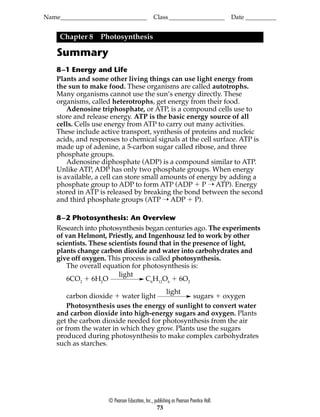
Photosynthesis Notes
- 1. © Pearson Education, Inc., publishing as Pearson Prentice Hall. 73 Name____________________________ Class__________________ Date __________ Chapter 8 Photosynthesis Plants and some other living things can use light energy from the sun to make food. These organisms are called autotrophs. Many organisms cannot use the sun’s energy directly. These organisms, called heterotrophs, get energy from their food. Adenosine triphosphate, or ATP, is a compound cells use to store and release energy. ATP is the basic energy source of all cells. Cells use energy from ATP to carry out many activities. These include active transport, synthesis of proteins and nucleic acids, and responses to chemical signals at the cell surface. ATP is made up of adenine, a 5-carbon sugar called ribose, and three phosphate groups. Adenosine diphosphate (ADP) is a compound similar to ATP. Unlike ATP, ADP has only two phosphate groups. When energy is available, a cell can store small amounts of energy by adding a phosphate group to ADP to form ATP (ADP ϩ P ➝ ATP). Energy stored in ATP is released by breaking the bond between the second and third phosphate groups (ATP ➝ ADP ϩ P). 8–2 Photosynthesis: An Overview Research into photosynthesis began centuries ago. The experiments of van Helmont, Priestly, and Ingenhousz led to work by other scientists. These scientists found that in the presence of light, plants change carbon dioxide and water into carbohydrates and give off oxygen. This process is called photosynthesis. The overall equation for photosynthesis is: 6CO2 ϩ 6H2 O light C6 H12 O6 ϩ 6O2 carbon dioxide ϩ water light light sugars ϩ oxygen Photosynthesis uses the energy of sunlight to convert water and carbon dioxide into high-energy sugars and oxygen. Plants get the carbon dioxide needed for photosynthesis from the air or from the water in which they grow. Plants use the sugars produced during photosynthesis to make complex carbohydrates such as starches. Summary 8–1 Energy and Life
- 2. Name____________________________ Class__________________ Date __________ Photosynthesis also requires light and chlorophyll. Plants gather the sun’s energy with light-absorbing molecules called pigments. The main pigment in plants is chlorophyll. A com- pound that absorbs light also absorbs the light’s energy. When chlorophyll absorbs sunlight, much of the light energy is sent directly to electrons in the chlorophyll molecules. This raises the energy levels of the electrons. The visible spectrum is made up of wavelengths of light you can see. This spectrum contains all the colors. Chlorophyll absorbs light in the blue-violet and red regions of the visible spectrum well. Chlorophyll does not absorb light in the green region well. Plants look green because their leaves reflect this green light. 8–3 The Reactions of Photosynthesis In plants and other photosynthetic prokaryotes, photosynthesis takes place inside the chloroplasts. Chloroplasts have saclike photosynthetic membranes called thylakoids. Proteins in the thylakoid membrane organize chlorophyll and other pigments into clusters known as photosystems. The photosystems are the light-collecting units of chlorophyll. When sunlight excites electrons in chlorophyll, the electrons gain energy. The electron transfers its energy to another molecule. The energy continues to move from molecule to molecule until it gets to the end of the chain. The reactions of photosynthesis occur in two parts: light- dependent reactions and light-independent reactions. 1. The light-dependent reactions produce oxygen gas and convert ADP and NADPϩ into ATP and NADPH. These reactions need light and they occur in the thylakoid membranes. The light-dependent reactions can be divided into four processes: light absorption, oxygen production, electron transport, and ATP formation. The light-dependent reactions use water, ADP, and NADPϩ . They produce oxygen, ATP, and NADPH. 2. The light-independent reactions are also called the Calvin cycle. These reactions do not need light. The Calvin cycle uses ATP and NADPH from the light-dependent reactions to pro- duce high-energy sugars. The Calvin cycle takes place in the stroma of chloroplasts. The Calvin cycle uses carbon dioxide in its reactions. As photosynthesis proceeds, the Calvin cycle works steadily to remove carbon dioxide from the atmosphere and turn out energy-rich sugars. Six carbon dioxide molecules are needed to make a single 6-carbon sugar. Many factors affect the rate of photosynthesis. Such factors include water availability, temperature, and the intensity of light. © Pearson Education, Inc., publishing as Pearson Prentice Hall. 74